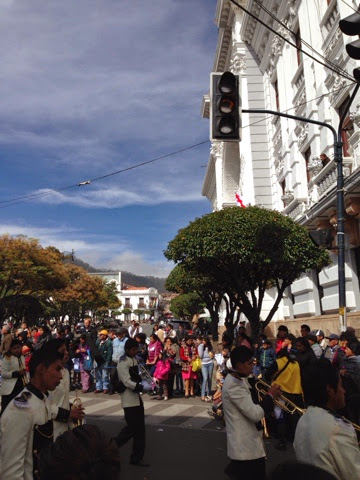We went to the tour company and paid for our experience then headed up the road to collect our shoes and helmets. It became clear at that point that instead of 3 of climbing at once like we had been promised, there was going to be only 1 climbing at a time while the rest of us would have to sit around and wait. As this was quite a significant change we were not too happy and tried to get a discount. The instructor said it was out of his hands and would have to go back down to the office to ask them. We did just that and after about half an hour of Fred arguing with them (and the poor girl nearly being in tears) we managed to get them to agree to collect an extra rope along the way and we could belay someone as well as the instructor. They were pretty reluctant to agree to this due to safety restrictions - who knew you'd ever have to worry about that in Bolivia? Given Jimmy belays for a job, it really wasn't an issue though.
The only perk of having wasted about an hour trying to get it all sorted was we at least got to see more of the celebrations going on as the Independence Day festivities were continuing on. As you can see, part of their traditional dress is the bowler hat which dates back to the 1920s when British railway workers introduced them to Bolivia.
I was pretty nervous about climbing as I think the last time I had done it was at OPC 15 years ago. I remembered loving it but looking up at the height of the wall I couldn't help but be a bit scared of how I would go. It turned out that I didn't need to feel nervous as I loved it as soon as I was hauling myself up the rock face.
We headed back down into the city for our free beer then headed around the place in search of a non gringo food joint. We have found this to be harder than it sounds as we always seem to be eating at the wrong times and so the restaurants are either closed for siesta or closed for the night. This time it was closed for siesta so we had to make do with a place right on the plaza which of course is boring, overpriced gringo food. It filled that gap though and before long the wolf pack was saying their farewells and we split off into 3 in order to head our different ways.
Dmitry, Jimmy & I were pretty excited to get on our bus and see what a step up cama is to semi cama. Well worth the extra $5 or so when you're doing a 12 hour bus ride. Next stop, La Paz.

























































